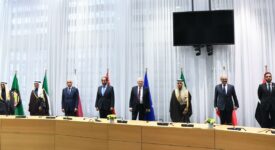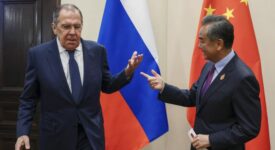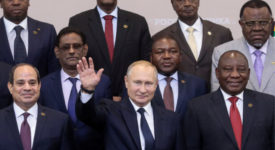The European Union’s Global Gateway investment initiative presents African governments with an attractive mechanism for pursuing sustainable infrastructure development that looks beyond aid. Considering the infrastructure deficit which Africa faces — and its sordid history with loans, aid and the non-delivery of projects — this is undoubtedly good news for the continent. Touted as Europe’s strategy to “connect the world together”, the Global Gateway aims to narrow the global infrastructure investment gap by mobilizing €300-billion in investments between 2021 and 2027. These investments will focus specifically on developing sustainable and high-quality infrastructure across a range of sectors including health, climate and energy, digital, transportation, education and research. During the program’s announcement in Brussels, the President of the European Commission, Ursula von der Leyen, described it as “the European Union’s plan for major investment in infrastructure development around the world”.
This is in many ways an unsurprising maneuver from the bloc that comprises 27 member states, three of which are among the world’s 10 largest economies. The EU is responsible for providing over €50-billion a year to help overcome poverty and advance global development, making it one of the world’s largest contributors of official development assistance (ODA). Indeed, the bloc has undertaken similar initiatives in the past, including the 2018 EU-Asia Connectivity Strategy which sought to mobilize and strengthen cooperation between the two partners by engaging with private investors, national and international institutions and multilateral development banks. More important is that Global Gateway comes at a time when other countries and alliances are spearheading sustainability-focused investment programs of their own: the G7, under the leadership of the United States, launched the Build Back Better World (B3W) partnership which aims to mobilize funds in an effort to narrow the $40-trillion infrastructure need in the developing world; meanwhile UK Prime Minister Boris Johnson has announced the UK’s Clean Green Initiative at COP26 to help developing countries take advantage of green technology and grow their economies sustainably.
And of course there is China’s Belt and Road Initiative (BRI), which although it does not prioritize green and sustainable developments, has invested an estimated $900-billion in global infrastructure projects and is forecast to reach as much as $1.3-trillion by 2027. Some have been quick to suggest an air of geopolitics amid all of this, labelling the Global Gateway an attempt by the EU to rival China and the influence of its BRI. Regardless of the realpolitik which may or may not surround the Global Gateway, it presents African governments with a break from the status quo; an attractive mechanism for pursuing sustainable infrastructure development which looks beyond aid to encompass multi-stakeholder input and partnership. Considering the infrastructure deficit which Africa faces and its sordid history with loans, aid and the non-delivery of projects, this is undoubtedly good news for the continent.
AFRICA’S INFRASTRUCTURE DEFICIT —- There is a tremendous backlog in Africa’s infrastructure and an even wider financing gap. Between 1980 and 1998 the continent’s spending on infrastructure fell to just over 1% of GDP. Today that number is estimated to be closer to 3.5%, but still significantly low when considering that China spends roughly 7.7% of its GDP on infrastructure while India allocates 5.2%. A 2018 report from the African Development Bank (AfDB) suggests that the continent’s infrastructure needs amount to $130- to $170-billion a year, with a financing gap in the range of $68- to $108-billion. This is Africa’s infrastructure deficit. Africa suffers from severe disparities across a variety of infrastructure domains, including energy, transportation, healthcare and digital connectivity.
Over 640 million Africans — 44% of the continent’s population — lack access to electricity. In Nigeria for example, 85 million citizens are without electricity. There is also the issue of reliability and maintenance of existing energy infrastructure. The continent’s rail network is equally underwhelming. Africa boasts 84,000km of rail track over a surface of 30 million square kilometers, with 13 countries having no operational rail network to speak of. For those countries that do have relatively operational networks, they are typically fitted with outdated infrastructure and are poorly maintained. Unsurprisingly, most of the continent’s goods — some 80% — are transported via road. Yet despite this reliance, large swathes of the continent’s roads are unpaved or poorly maintained, with some estimates suggesting that Africa has approximately 31km of paved road per 100km² of land.
The Covid-19 pandemic highlighted the inequalities that plague Africa’s healthcare infrastructure. Current expenditure on health across African countries averaged 5.1% of GDP in 2018, with only 6% of total public health spending going towards developing health infrastructure. By comparison, many Asian and Latin American countries allocate more than 20% of government health expenditure towards infrastructure. Somewhat of a silver lining is the mobile penetration rate across the continent and the growing access to the internet. There are 495 million unique mobile subscribers on the continent, 28% of whom have access to the internet through their mobile devices, a figure which is expected to grow to 39% by 2025. The drawback, however, is the cost of data. In 2020, the median price of a gig of mobile data in Africa was more than $5, with prices reaching as high as $35 in Equatorial Guinea. These are startling figures given that 431 million Africans live in extreme poverty (living on less than $1.90 a day).
A report by Deloitte shows that while transportation projects dominate infrastructure spending, accounting for 42% of the continent’s total number of infrastructure developments in 2020, other key sectors such as healthcare and education linger at 2% and 1% respectively. Another tell-tale indicator detailed in the report is that the majority of infrastructure developments — roughly 73% — do not exceed $500-million in value. This does not bode well for a continent that is expected to undergo rapid growth throughout the century. Africa’s population is projected to increase rapidly from 1.3 billion in 2020 to 2.5 billion in 2050, with its urban population expected to grow from 588 million to 1.5 billion during the same period. This surge presents a number of challenges for the continent. Among these are the provision of food for the extra billion people; availability of healthcare and treatment facilities; housing for the influx of urban migrants; transport systems to facilitate trade; and reliable energy systems to power the continent’s cities, communities and businesses. Scaling up infrastructure will be vital to match the demands of Africa’s population boom and to accommodate economic growth.
CHOOSING PARTNERSHIPS FOR GROWTH —- There is a growing opportunity to address the continent’s infrastructure deficit through partnerships. Leveraging partner institutions and encouraging greater private sector investment is key towards sustained infrastructure development across the continent. This is the sentiment shared by Pierre Guislain, Vice-President for Private Sector, Infrastructure and Industrialization at the AfDB. If Africa is to make progress in addressing its infrastructure deficit, then it will need to prioritize positive-sum partnerships. African governments, therefore, need to be deliberate about who they choose to partner with, not only opting for those who can offer attractive funding packages, but who are reliable, skilled, transparent and who understand the broader landscape.
Ambassador Riina Kionka, who serves as the EU Ambassador to South Africa, is confident that the Global Gateway provides a new and attractive model for financing Africa’s infrastructure deficit. “We [the EU] want to make the investment process fairer and more rules-based and do it in such a way that contributes towards sustainability”, notes Kionka, adding that “I do see a number of opportunities here. Africa is Europe’s neighbor and so we have a huge interest in the prosperity and success of African countries.” In many ways, the Global Gateway is not new, and for Eurosceptics it may be more of a PR project than a decisive infrastructure master plan. Indeed, it has been criticized as simply a mixture of existing commitments and loan guarantees bundled together under a new banner — old wine in new bottles, as the saying goes.
The EU already disburses €19.8-billion to Africa; is the solution to the continent’s infrastructure deficit simply throwing more money at it? To begin with, the Global Gateway is a partnership and not simply an aid disbursement program. In his most recent book, Expensive Poverty: Why Aid Fails and How it Can Work, Dr Greg Mills of the Brenthurst Foundation outlines why generous sums of money from donors do not necessarily serve as a silver bullet for solving Africa’s infrastructure deficit. “The answer to Africa’s infrastructure shortfalls”, notes Mills, “lies in improving the store of human capital and applying transparent tendering processes and revenue models to make it pay for itself now and in the future.” This is what distinguishes the Global Gateway.
An EU team comprising member states and financial and development institutions will work with private sector partners to mobilize funds for select infrastructure projects. If structured correctly, this partnership will make headway in several areas. First, it will assuage many concerns that private sector actors might have about engaging in infrastructure projects on the continent alone, knowing that they have the support of the EU. Second, the makeup of the partnership will ensure that all parties have “skin in the game”, improving the likelihood that projects will progress from conceptualization through to completion. Finally, leveraging Europe’s private sector brings with it tremendous benefits in terms of expertise and human capital, especially in the areas of ICT and renewable energy.
An additional strength is that partnerships promote multi-stakeholder buy-in, which in turn encourages accountability and transparency. The Global Gateway is an EU initiative and is therefore an extension of the bloc’s values and interests. Again, this program is intended to be fair and rules-based. This philosophy will go a long way in ensuring that financing is transparent, thereby removing any forms of predatory lending (what some have called “debt-trap diplomacy”, which is fundamentally extractive by nature). This is a major boon for Africa as it provides governments with an alternative to the BRI, which is increasingly seen as a deliberately opaque and predatory system. In an interview with CNN, Dr Bradley Parks, Executive Director of AidData, highlights how the BRI is not necessarily the jewel many have made it out to be: “The Belt and Road Initiative has really created major debt sustainability challenges for poor countries,” he says, adding that “Beijing really has a buyer’s remorse problem… many foreign leaders who were initially eager to jump on the Belt and Road bandwagon are now suspending or canceling Chinese infrastructure projects because of debt sustainability concerns.”
Of course, if the Global Gateway is to prove successful, then partner governments across the continent will need to demonstrate their willingness to engage constructively. This will mean removing any expectations surrounding per diem payments and contracts for friends; so long as the EU and its partners are footing part of the bill, there won’t be any room for those sorts of activities. If implemented in the manner it is advertised, the Global Gateway can play a significant role in addressing Africa’s infrastructure deficit, serving as an arrow in the continent’s development quiver; a stepping-stone towards overcoming development and connectivity challenges through partnership, accountability and private sector engagement. The Global Gateway, as its name would suggest, offers a new and exciting window of opportunity at a time when development — especially infrastructure — is under increasing pressure to be sustainable. “I would like to see fewer news headlines about ports being taken over and countries becoming increasingly indebted,” replies Kionka when asked about the desired impact of the Global Gateway on Africa. On paper it certainly appears to be the change of tack Africa needs. Only time will tell, and so we shall wait until 2027 with bated breath to see the results.
‘Levelling-up with Brussels: The European Union’s Global Gateway Is Good News for Africa’ — Commentary by Richard Morrow —The Brenthurst Foundation.







